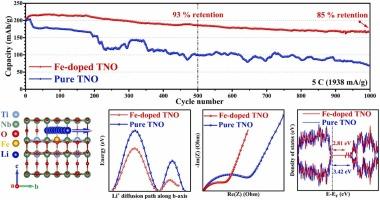当前位置:
X-MOL 学术
›
Nano Energy
›
论文详情
Our official English website, www.x-mol.net, welcomes your
feedback! (Note: you will need to create a separate account there.)
Fe3+-substitutional Doping of Nanostructured Single-crystal TiNb2O7 for Long-stable Cycling of Ultra-fast Charging Anodes
Nano Energy ( IF 16.8 ) Pub Date : 2024-11-20 , DOI: 10.1016/j.nanoen.2024.110494 Fan Yu, Bobby Miglani, Shuaishuai Yuan, Rana Yekani, Kirk H. Bevan, George P. Demopoulos
Nano Energy ( IF 16.8 ) Pub Date : 2024-11-20 , DOI: 10.1016/j.nanoen.2024.110494 Fan Yu, Bobby Miglani, Shuaishuai Yuan, Rana Yekani, Kirk H. Bevan, George P. Demopoulos

|
Titanium niobate (TiNb2O7, TNO) has emerged as a promising lithium-ion battery (LIB) anode option for fast charging applications. However, the cycling durability of TNO under extremely fast charging is still limited, and the corresponding structural alteration mechanism remains unclear. This research reports an ultra-fast charging anode with long-term cycling stability enabled by Fe substitution in single-crystal TNO nanostructures. The underlying mechanism via which Fe substitution affects TNO’s electronic properties, ionic diffusion kinetics, and structural stability is revealed through combined theoretical modeling and experimental characterization. The optimal Fe3+-doped TNO monocrystalline material (Fe0.05Ti0.95Nb2O6.975) (Fe5-TNO) provides a remarkable charge capacity of 238 mAh/g under a 10 C (6 min charging time only) extreme fast-charging protocol (coupled with 1 C discharge), and a high capacity of 200 mAh/g at 5 C with high cycling retention of 85% after 1000 cycles. Our calculations suggest that Fe3+ substitutional doping leads to a lowering of the band gap coupled with a reduction in the Li+ diffusion energy barrier. Overall, these factors contribute to reduced capacity decay and extreme fast charging, together promoting durable cycling performance suitable for LIB usage. Reflection electron energy loss spectroscopy (REELS) reveals that Fe3+ doping narrows the band gap from 3.75 eV of TNO to approximately 3.40 eV for Fe5-TNO; after initial lithiation, both TNO and Fe3+-doped TNO are transformed into a higher-conductivity phase, in agreement with density functional theory (DFT) predictions. Meanwhile Fe3+ doping is shown exhibited to decrease the Li+ diffusion energy barrier, boosting the Li+ diffusion coefficient by one order of magnitude, from 10-13 to 10-12 cm2/s. This research provides new insights into the design of next-generation fast-charging LIB anodes via DFT-guided substitutional doping.
中文翻译:

纳米结构单晶 TiNb2O7 的 Fe3+ 取代掺杂用于超快速充电负极的长期稳定循环
铌酸钛 (TiNb2O7, TNO) 已成为一种很有前途的锂离子电池 (LIB) 阳极选择,适用于快速充电应用。然而,TNO 在极速充电下的循环耐久性仍然有限,相应的结构改变机制尚不清楚。这项研究报道了一种超快速充电阳极,通过在单晶 TNO 纳米结构中取代 Fe 实现长期循环稳定性。通过结合理论建模和实验表征,揭示了 Fe 取代影响 TNO 电子性质、离子扩散动力学和结构稳定性的潜在机制。最佳的 Fe3+ 掺杂 TNO 单晶材料 (Fe0.05Ti0.95Nb2O6.975) (Fe5-TNO) 在 10C(仅充电时间)极速充电协议(耦合 1C 放电)下提供 238mAh/g 的显着充电容量,在 5C 时具有 200mAh/g 的高容量,1000 次循环后循环保持率高达 85%。我们的计算表明,Fe3+ 取代掺杂导致带隙降低,同时 Li+ 扩散能垒减少。总体而言,这些因素有助于减少容量衰减和极快的充电速度,共同促进适合 LIB 使用的持久循环性能。反射电子能量损失光谱 (REELS) 显示,Fe3+ 掺杂使 TNO 的带隙从 3.75eV 缩小到 Fe5-TNO 的约 3.40eV;初始锂化后,TNO 和 Fe3+ 掺杂的 TNO 都转化为更高电导率的相,这与密度泛函理论 (DFT) 的预测一致。 同时,Fe3+ 掺杂表明降低了 Li+ 扩散能垒,将 Li+ 扩散系数提高了一个数量级,从 10-13 增加到 10-12 cm2/s。这项研究为通过 DFT 引导的替代掺杂设计下一代快速充电 LIB 负极提供了新的见解。
更新日期:2024-11-20
中文翻译:

纳米结构单晶 TiNb2O7 的 Fe3+ 取代掺杂用于超快速充电负极的长期稳定循环
铌酸钛 (TiNb2O7, TNO) 已成为一种很有前途的锂离子电池 (LIB) 阳极选择,适用于快速充电应用。然而,TNO 在极速充电下的循环耐久性仍然有限,相应的结构改变机制尚不清楚。这项研究报道了一种超快速充电阳极,通过在单晶 TNO 纳米结构中取代 Fe 实现长期循环稳定性。通过结合理论建模和实验表征,揭示了 Fe 取代影响 TNO 电子性质、离子扩散动力学和结构稳定性的潜在机制。最佳的 Fe3+ 掺杂 TNO 单晶材料 (Fe0.05Ti0.95Nb2O6.975) (Fe5-TNO) 在 10C(仅充电时间)极速充电协议(耦合 1C 放电)下提供 238mAh/g 的显着充电容量,在 5C 时具有 200mAh/g 的高容量,1000 次循环后循环保持率高达 85%。我们的计算表明,Fe3+ 取代掺杂导致带隙降低,同时 Li+ 扩散能垒减少。总体而言,这些因素有助于减少容量衰减和极快的充电速度,共同促进适合 LIB 使用的持久循环性能。反射电子能量损失光谱 (REELS) 显示,Fe3+ 掺杂使 TNO 的带隙从 3.75eV 缩小到 Fe5-TNO 的约 3.40eV;初始锂化后,TNO 和 Fe3+ 掺杂的 TNO 都转化为更高电导率的相,这与密度泛函理论 (DFT) 的预测一致。 同时,Fe3+ 掺杂表明降低了 Li+ 扩散能垒,将 Li+ 扩散系数提高了一个数量级,从 10-13 增加到 10-12 cm2/s。这项研究为通过 DFT 引导的替代掺杂设计下一代快速充电 LIB 负极提供了新的见解。


















































 京公网安备 11010802027423号
京公网安备 11010802027423号